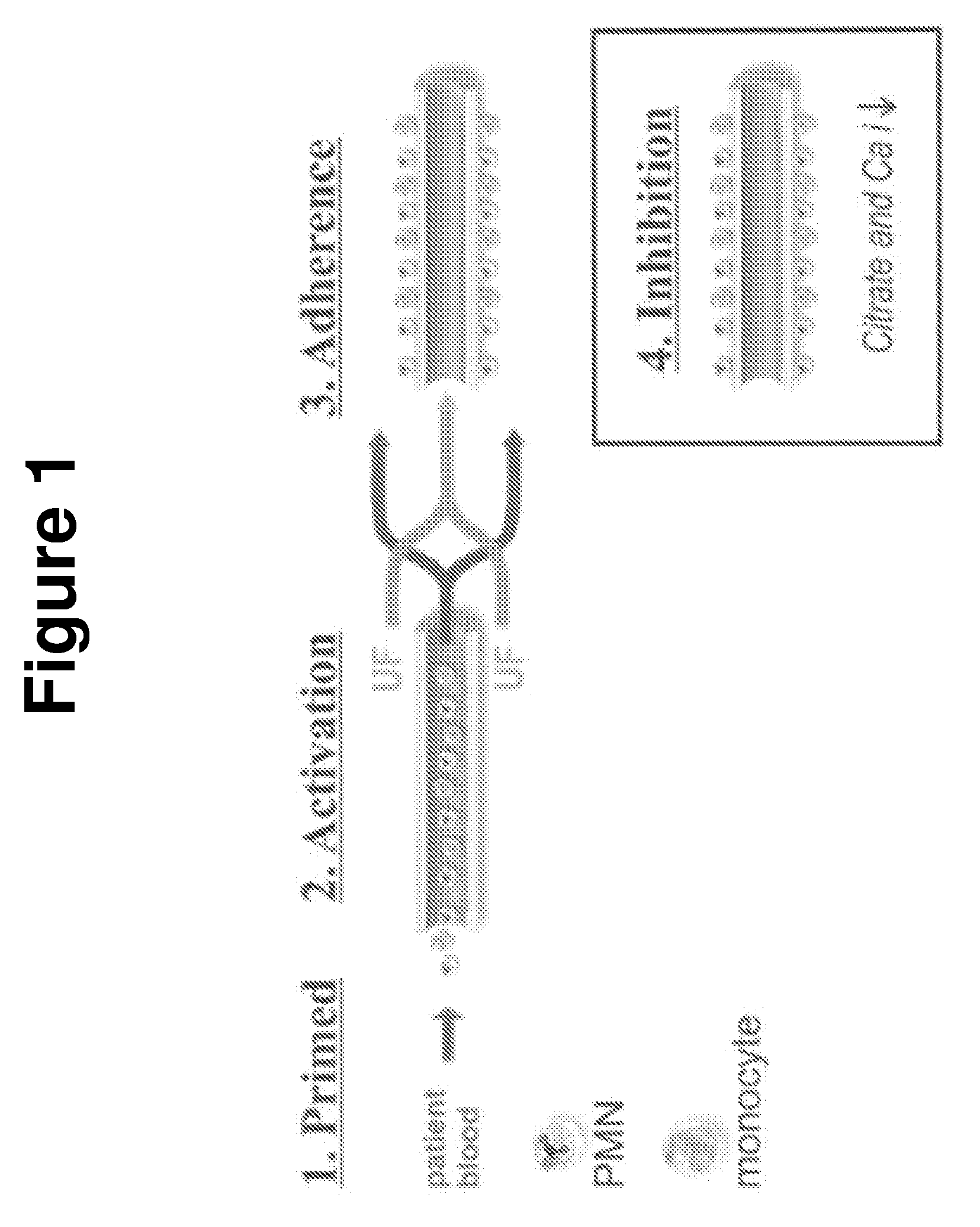Selective cytopheresis devices and related methods thereof
a cytopheresis device and cytopheresis technology, applied in the direction of antibacterial agents, peptide/protein ingredients, water/sewage treatment, etc., can solve the problems of life-threatening or even fatal, cardiovascular dysfunction, and homeostatic mechanisms involved in regulating cardiovascular and immune system function, and achieve the effect of inhibiting or deactivating the inflammatory action, deactivating the cells, and inhibiting the inflammatory action
- Summary
- Abstract
- Description
- Claims
- Application Information
AI Technical Summary
Benefits of technology
Problems solved by technology
Method used
Image
Examples
example 1
Treatment of Inflammation Associated with Acute Sepsis and Acute Renal Failure in an Animal Model
[0125]This example describes a series of experiments used to evaluate an embodiment of the present invention to treat inflammation associated with the conditions of acute sepsis and acute renal failure.
[0126](I) Background and Rationale
[0127]Leukocytes, especially neutrophils, are major contributors to the pathogenesis and progression of many clinical inflammatory disorders, including SIRS, sepsis, ischemia / reperfusion injury and acute respiratory distress syndrome (ARDS). A large number of therapeutic approaches are under investigation to limit the activation and tissue accumulation of leukocytes at sites of inflammation in order to minimize tissue destruction and disease progression. Severe sepsis with SIRS occurs in 200,000 patients annually in the U.S. with a mortality rate of 30-40%, even with use of intensive care units and broad spectrum antibiotics.
[0128]The origins of this resea...
example 2
In Vitro Studies of Leukocyte Sequestration and Inhibition and / or Deactivation
[0160]The experiment described in this example shows that leukocytes adhered to a dialysis membrane are inhibited and / or deactivated in the presence of citrate. In addition, other data have demonstrated that citrate anticoagulation abolishes degranulation of neutrophils (a calcium-dependent event) during hemodialysis of subjects with end stage renal disease (ESRD). To evaluate this process in more detail and expand it to other leukocyte populations and cytokine release, the following in vitro experiments were performed.
[0161]Methods and Materials
[0162]Leukocytes were isolated from normal healthy individuals using established methods. The leukocytes (106 cells per well) were placed into 12-well tissue culture plates containing 14×14 mm squares of polysulfone membranes (Fresenius, Walnut Creek, Calif.) and allowed to adhere for 60 minutes at 37° C. in RPMI media. The media was removed, cells washed with PBS,...
example 3
Treatment of Inflammation Associated with Acute Renal Failure (ARF) in Humans
[0167]The experiment described in this example shows the unexpected survival rates in human subjects treated with an embodiment of the present invention, namely, a SCID including hollow fiber tubes is in a system treated with citrate versus those patients treated with a similar device in a system treated with heparin. Specifically, in this experiment, SCID refers to a device of FIG. 7 in the circuit of FIG. 3. No renal cells were included in the ICS of the SCID.
[0168]Background
[0169]The safety and efficacy of renal cell therapy on ten critically ill patients with ARF and multiorgan failure receiving continuous venovenous hemofiltration (CVVH) previously was investigated in Phase I / II trials (see, e.g., Humes et al. (2004) Kidney Int. 66(4):1578-1588). The predicted hospital mortality rates for these patients averaged greater than 85%. The devices used in the previously reported trial were seeded with human ...
PUM
| Property | Measurement | Unit |
|---|---|---|
| surface area | aaaaa | aaaaa |
| time | aaaaa | aaaaa |
| shear stress | aaaaa | aaaaa |
Abstract
Description
Claims
Application Information
 Login to View More
Login to View More - R&D
- Intellectual Property
- Life Sciences
- Materials
- Tech Scout
- Unparalleled Data Quality
- Higher Quality Content
- 60% Fewer Hallucinations
Browse by: Latest US Patents, China's latest patents, Technical Efficacy Thesaurus, Application Domain, Technology Topic, Popular Technical Reports.
© 2025 PatSnap. All rights reserved.Legal|Privacy policy|Modern Slavery Act Transparency Statement|Sitemap|About US| Contact US: help@patsnap.com



